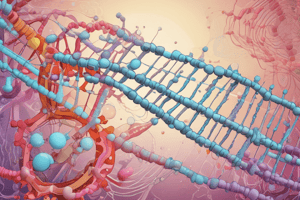Podcast
Questions and Answers
What is the primary function of the enzyme DNA polymerase in PCR?
What is the primary function of the enzyme DNA polymerase in PCR?
- To amplify RNA molecules
- To synthesize new DNA strands (correct)
- To ligate DNA fragments
- To degrade DNA strands
What is the purpose of oligonucleotides in PCR?
What is the purpose of oligonucleotides in PCR?
- To inhibit DNA synthesis
- To ligate DNA fragments
- To serve as primers for DNA synthesis (correct)
- To degrade RNA molecules
What is the main difference between PCR and RT-PCR?
What is the main difference between PCR and RT-PCR?
- PCR amplifies DNA, while RT-PCR amplifies RNA
- PCR is used for RNA, while RT-PCR is used for DNA
- PCR is used for genomic DNA, while RT-PCR is used for cDNA
- PCR uses DNA polymerase, while RT-PCR uses reverse transcriptase (correct)
What is the purpose of the second primer in RT-PCR?
What is the purpose of the second primer in RT-PCR?
What is the result of using an oligo (dT) primer in RT-PCR?
What is the result of using an oligo (dT) primer in RT-PCR?
What is the purpose of heat-stable Taq DNA polymerase in RT-PCR?
What is the purpose of heat-stable Taq DNA polymerase in RT-PCR?
How are the products of RT-PCR amplification typically analyzed?
How are the products of RT-PCR amplification typically analyzed?
What is the meaning of the Greek word 'klon' in the context of gene cloning?
What is the meaning of the Greek word 'klon' in the context of gene cloning?
Who performed the first cloning experiment in 1973?
Who performed the first cloning experiment in 1973?
In what year was human growth hormone (hGH) produced in E. coli?
In what year was human growth hormone (hGH) produced in E. coli?
Who discovered restriction endonucleases in E. coli?
Who discovered restriction endonucleases in E. coli?
What is the result of a cloning experiment?
What is the result of a cloning experiment?
In what year was human insulin, the first recombinant DNA product, approved?
In what year was human insulin, the first recombinant DNA product, approved?
Who cloned a sheep named Dolly in Scotland in 1997?
Who cloned a sheep named Dolly in Scotland in 1997?
What is the primary application of RT-PCR?
What is the primary application of RT-PCR?
What is the purpose of the reporter probe in real-time PCR?
What is the purpose of the reporter probe in real-time PCR?
What is the advantage of real-time PCR over traditional PCR?
What is the advantage of real-time PCR over traditional PCR?
What is the benefit of using restriction site sequences on the PCR primers?
What is the benefit of using restriction site sequences on the PCR primers?
What is the outcome of using RT-PCR to analyze a sample?
What is the outcome of using RT-PCR to analyze a sample?
What is the role of the fluorescent tag in real-time PCR?
What is the role of the fluorescent tag in real-time PCR?
What is the significance of the quenching tag in real-time PCR?
What is the significance of the quenching tag in real-time PCR?
What is the advantage of using M13 phage vectors?
What is the advantage of using M13 phage vectors?
What is the purpose of Fluorescence In Situ Hybridization (FISH)?
What is the purpose of Fluorescence In Situ Hybridization (FISH)?
What is the result of C banding in chromosome identification?
What is the result of C banding in chromosome identification?
What is the purpose of Comparative Genome Hybridization (CGH)?
What is the purpose of Comparative Genome Hybridization (CGH)?
What is the characteristic of cosmids?
What is the characteristic of cosmids?
What is the purpose of electroporation?
What is the purpose of electroporation?
What is the characteristic of Charon phages?
What is the characteristic of Charon phages?
What is the result of high-resolution banding in chromosome identification?
What is the result of high-resolution banding in chromosome identification?
What is the purpose of phagemids?
What is the purpose of phagemids?
Flashcards are hidden until you start studying
Study Notes
PCR (Polymerase Chain Reaction)
- Amplifies a region of DNA between two predetermined sites using oligonucleotides as primers
- Each cycle of PCR doubles the number of copies of the amplified DNA until a large quantity is made
- Developed by Kary Mullis and his colleagues in the 1980s
Reverse Transcription-PCR (RT-PCR)
- Uses the enzyme reverse transcriptase to synthesize DNA strands that are complementary to RNA templates
- Can be used to clone a cDNA from just one mRNA
- Starts with an mRNA and reverse transcribes it to make a single-stranded DNA, then uses a forward primer to convert it to double-stranded DNA
- The resulting DNA strands can be amplified by standard PCR
Analysis of RNA by RT-PCR
- Uses RT-PCR to generate a cDNA from a single type of mRNA
- The sequence of the mRNA must be known to design the primer for the PCR step
- Restriction site sequences can be placed on the PCR primers, making it easy to cleave and ligate the cDNA into a vector
- Many modifications of the RT-PCR procedure have been developed to make it more quantitative
- Allows for the quick and easy determination of whether a particular gene is being transcribed
Real-Time PCR
- Quantifies the amplification of a DNA as it occurs (in real-time)
- Uses a reporter probe that is annealed to the DNA strand, which has a fluorescent tag and a fluorescence quenching tag
- As the DNA polymerase extends the primers, the reporter probe is degraded, separating the fluorescent tag from the quenching tag, allowing for the measurement of fluorescence
Gene Cloning
- A product of any cloning experiment is a clone, a group of identical cells or organisms
- The first gene cloning experiment was performed by Stanley Cohen, Herbert Boyer, and their colleagues in 1973
- Clones of identical frogs were created by John Gurdon, and the first mammal to be cloned was a sheep named Dolly in 1997
The Role of Restriction Endonucleases
- Discovered by Stewart Linn and Werner Arber
- Used in gene cloning to cut DNA at specific sequences
Vectors
- Phages as vectors have a natural advantage over plasmids
- Charon phages can accept up to 20 KB of DNA
- Cosmids are designed for cloning large DNA fragments and can behave as both plasmids and phages
- M13 phage vectors produce single-stranded DNA, which can be recovered in single-stranded form
- Phagemids produce single-stranded DNA and have characteristics of both phages and plasmids
Chromosome Identification
- There are three commonly used staining methods to distinguish among human chromosomes: G-banding, Q-banding, and R-banding
- G-banding is the most common method used in clinical laboratories
- Q-banding requires staining with quinacrine mustard or related compounds and examination by fluorescence microscopy
- R-banding involves heating before staining, resulting in dark and light bands that are the reverse of those produced by G or Q banding
Special Cytological Procedures
- C-banding stains the centromeric region of each chromosome and other regions containing constitutive heterochromatin
- High-resolution banding (prometaphase banding) is achieved through G-banding or R-banding techniques to stain chromosomes
- Fragile sites are non-staining gaps that are occasionally observed at characteristic sites on several chromosomes
Fluorescence In Situ Hybridization (FISH)
- A technique to examine the presence or absence of a particular DNA sequence or to evaluate the number or organization of a chromosome or chromosomal region
- Identifies particular chromosomal rearrangements or rapidly diagnoses the existence of an abnormal chromosome number in clinical material
Chromosome and Genome Analysis by Microarrays
- Comparative genome hybridization (CGH) complements conventional karyotyping and provides a more sensitive, high-resolution assessment of the genome
- Reveals variants, particularly small changes in copy number between samples, that are of uncertain clinical significance
Studying That Suits You
Use AI to generate personalized quizzes and flashcards to suit your learning preferences.




